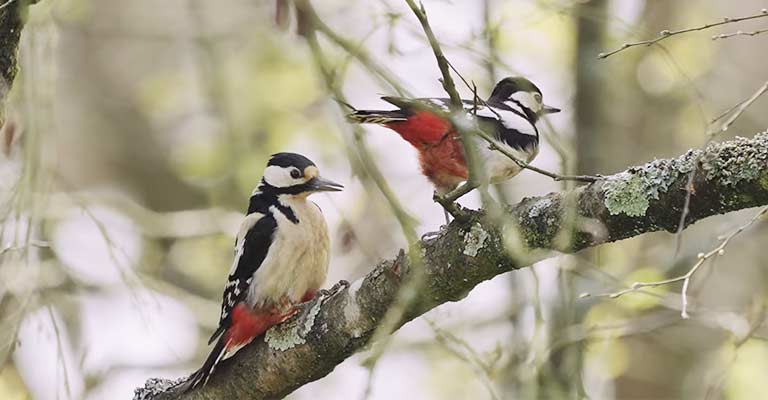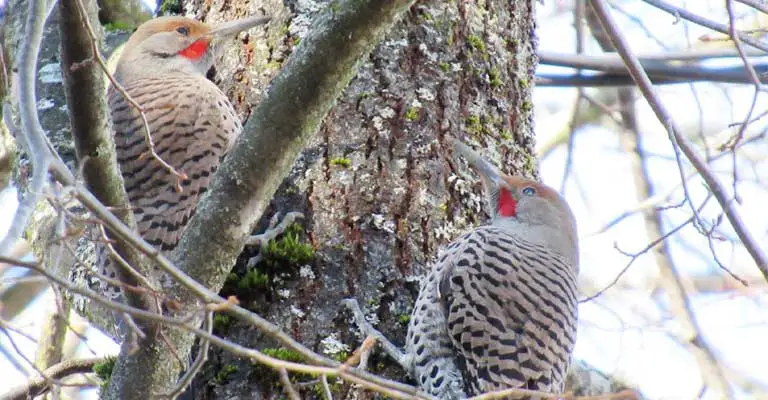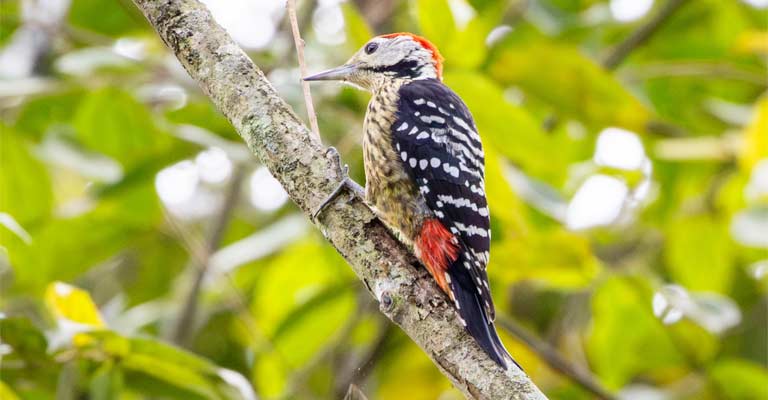In the heart of North American forests, a captivating spectacle unfolds as the magnificent pileated woodpeckers engage in a rhythmic dance of courtship.
These striking birds, with their striking crimson crests and powerful beaks, are not just skilled carpenters of the woods but also maestros of love.
Join us on a journey into the secretive world of pileated woodpecker mating behavior, where nature’s symphony is composed of drumming echoes and vibrant displays.
As the forest comes alive with the resonant percussion of their powerful beaks on hollow trees, these charismatic woodpeckers embark on a quest for companionship.
From intricate courtship calls to elaborate displays of vitality, the mating rituals of pileated woodpeckers reveal a fascinating interplay of instinct and elegance.
Explore the nuances of their courtship behaviors, decoding the language of love in the wild, as we unravel the mysteries behind the pileated woodpecker’s enchanting mating rituals.

Pileated Woodpecker Mating Behavior Unveiled
In the heart of North American forests, the pileated woodpecker, with its distinctive appearance and commanding presence, engages in a fascinating dance of courtship.
This captivating avian species, characterized by its striking crimson crest and powerful beak, not only serves as a skilled architect of the woods but also showcases intricate mating rituals that offer a glimpse into the complex world of avian relationships.
Overview of Pileated Woodpeckers
Before delving into their mating behavior, understanding the basic characteristics of pileated woodpeckers provides a foundation for appreciating the intricacies of their courtship rituals.
Scientifically known as Dryocopus pileatus, these large woodpeckers are the largest species in North America, measuring up to 19 inches in length, with a wingspan of about 30 inches.
Their distinctive appearance includes a vibrant red crest on the head, black plumage, and a white stripe running down their neck.
Pileated woodpeckers are primarily found in mature forests, where they thrive in a variety of habitats ranging from coniferous and deciduous forests to wooded suburbs.
Their preferred diet consists of insects, especially carpenter ants, wood-boring beetle larvae, and various other insects found within the bark of trees.
As solitary birds, they are territorial and often communicate through drumming, a behavior that plays a crucial role in their courtship rituals.
Drumming as a Communication Tool
One of the most notable aspects of pileated woodpecker mating behavior is the use of drumming as a form of communication.
This rhythmic percussion serves multiple purposes, including establishing territory, attracting mates, and maintaining social bonds.
Pileated woodpeckers are renowned for their powerful drumming, which resonates through the forest and can be heard over considerable distances.
During the breeding season, which typically occurs from late winter to early spring, male pileated woodpeckers intensify their drumming as a means of signaling their availability to potential mates.
The distinctive sound, resembling a rapid and resonant series of beats, is a key element of their courtship repertoire.
Each drumming sequence is unique to the individual, allowing woodpeckers to distinguish one another and communicate effectively in their wooded domains.
Elaborate Courtship Displays

The courtship displays of pileated woodpeckers are a spectacle to behold. As a prelude to pairing, males engage in a series of elaborate displays designed to showcase their vitality and attract a mate.
These displays often involve a combination of vocalizations, wing-spreading, and other visually striking behaviors.
The male pileated woodpecker, with its vibrant red crest, raised high, emits distinctive calls to capture the attention of potential mates.
These calls serve as both an announcement of presence and a means of reinforcing bonds with a chosen partner.
The visual elements of courtship displays include wing-flapping, head bobbing, and a variety of postures that highlight the bird’s physical prowess and overall health.
Selection of Nesting Sites
Once a pair forms, the selection of a suitable nesting site becomes a crucial phase in the reproductive process. Pileated woodpeckers are cavity nesters, meaning they excavate holes in dead or decaying trees to create nests for raising their young.
The process of choosing the right nesting site involves careful evaluation of the tree’s condition, accessibility, and suitability for providing a secure environment for the upcoming brood.
Both male and female pileated woodpeckers participate in the excavation process, using their powerful beaks to create cavities that can be up to 24 inches deep. The chosen tree is typically one with soft heartwood, making excavation more manageable.
The cavity-building process may take several weeks, and the final result serves as not just a nest but a testament to the pair’s commitment to reproduction.
Conservation Significance
Understanding and appreciating the mating behavior of pileated woodpeckers holds significance beyond the realm of ornithology.
As integral components of mature forest ecosystems, these woodpeckers contribute to controlling insect populations and play a vital role in the health of wooded habitats.
Conservation efforts that protect and preserve these ecosystems are essential for ensuring the continued success of pileated woodpecker populations and maintaining the delicate balance of biodiversity in North American forests.
The intricate dance of love displayed by pileated woodpeckers during their mating rituals unveils a world of fascinating behaviors, from drumming echoes that resonate through the forest to elaborate courtship displays and cooperative parental care.
What Happens After Mating?

The mating ritual of pileated woodpeckers marks the beginning of a fascinating journey that extends beyond the act itself.
As these iconic birds navigate the intricacies of parenthood, territory, and survival, let’s delve into the post-mating behaviors that shape the next chapters of their lives.
Nesting and Habitat Selection
After a successful mating, pileated woodpeckers embark on the crucial task of selecting a suitable nesting site. These birds are cavity nesters, and they exhibit a preference for excavating their nesting holes in dead or decaying trees.
The pair works collaboratively to create a nesting cavity, a process that may take several weeks. This meticulous effort ensures a secure and well-insulated home for their future offspring.
Egg-Laying and Incubation
Following the completion of the nesting cavity, the female pileated woodpecker lays a clutch of eggs, typically ranging from 3 to 5. Incubation duties are shared by both parents, with each taking turns to keep the eggs warm and protected.
This period, which lasts for about 15 to 18 days, requires dedicated care as the parents anticipate the arrival of their chicks.
Parental Care and Feeding
Upon hatching, the demanding phase of parental care commences. Pileated woodpecker parents work tirelessly to provide nourishment for their hungry chicks. Their diet includes a variety of insects, fruits, and nuts.
The feeding process involves the parents regurgitating partially digested food into the gaping mouths of their chicks. This cycle repeats until the young woodpeckers are ready to fledge, usually around 28 to 30 days after hatching.
Fledging and Independence

As the chicks grow and develop their flight feathers, they reach the fledging stage. Fledging marks the beginning of their independence, as they leave the nest and explore the surrounding environment.
However, even after leaving the nest, the juvenile woodpeckers may continue to receive support and guidance from their parents for a period as they refine their foraging and survival skills.
Territory Establishment and Defense
Post-mating, pileated woodpeckers establish and defend their territories. Territories are crucial for securing sufficient food sources and suitable nesting sites.
The male and female work together to defend their chosen area, often through vocalizations, drumming, and physical displays.
These displays serve as warnings to other woodpeckers, signaling the boundaries of their territory and the need for respectful distance.
Seasonal Dynamics: Winter Survival
In colder months, the dynamics of pileated woodpecker behavior shift as they focus on winter survival. Their diet adapts to include more fruits and nuts, and they may join mixed-species flocks for added protection and foraging opportunities.
The pair’s bond established during the mating season remains strong, contributing to their collaborative efforts in navigating the challenges of winter.
The post-mating journey of pileated woodpeckers unfolds as a captivating saga of nesting, parenting, territoriality, and adaptation.
Beyond the initial courtship and mating rituals, these birds invest time and energy into ensuring the survival of their offspring and the continuity of their lineage.
Their behaviors reflect the intricate balance between the instinctual drive for survival and the nurturing bonds that define the essence of family among these majestic woodpeckers.
FAQs
Why do pileated woodpeckers engage in drumming behavior during the mating season?
Pileated woodpeckers use drumming primarily as a form of communication. During the mating season, males intensify their drumming to establish territory, attract potential mates, and reinforce social bonds with other woodpeckers.
How long does the courtship phase last for pileated woodpeckers?
The courtship phase for pileated woodpeckers typically occurs during late winter to early spring, aligning with their breeding season. This period involves elaborate displays, vocalizations, and drumming to attract and secure a mate.
What is the significance of the pileated woodpecker’s cavity-nesting behavior?
Pileated woodpeckers are cavity nesters, meaning they excavate holes in dead or decaying trees to create nests for raising their young. This behavior is significant as it provides a secure and sheltered environment for incubating eggs and raising nestlings.
Do both male and female pileated woodpeckers participate in nest excavation?
Yes, both male and female pileated woodpeckers actively participate in the excavation process when creating nesting cavities. This cooperative effort highlights the commitment of the pair to reproduction.
How can conservation efforts benefit pileated woodpecker populations?
Conservation efforts aimed at preserving mature forest ecosystems are crucial for the well-being of pileated woodpecker populations. Protecting these habitats ensures a continuous supply of suitable nesting sites, foraging opportunities, and a balanced ecosystem.
Conclusion
The vibrant forest tapestry of the pileated woodpecker’s mating rituals leaves us awe-inspired by the intricacies of nature’s dance.
Through drumming echoes and flamboyant displays, these charismatic birds weave a tale of courtship that transcends the ordinary.
As we delve into their world, it becomes clear that their mating behavior is not just a biological imperative but a celebration of life in the heart of the wilderness.
Witnessing the pileated woodpeckers in their quest for love underscores the delicate balance that exists in the natural world.
From the primal drumming resonating through the trees to the delicate courtship calls, each moment is a testament to the enduring power of connection in the wild.
As we reflect on their captivating dance, let it serve as a reminder of the importance of preserving these wild spaces, ensuring that future generations can continue to marvel at the enchanting spectacle of love in the heart of the forest.